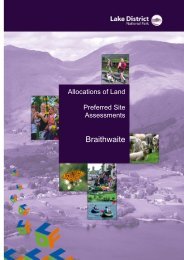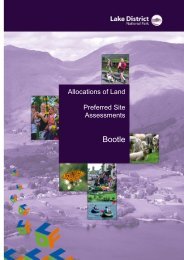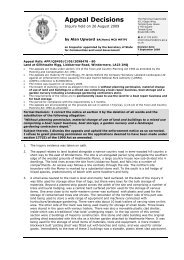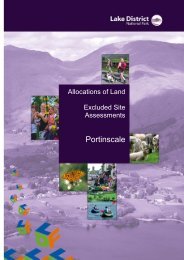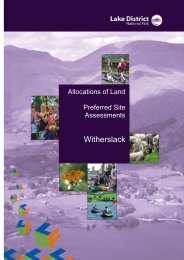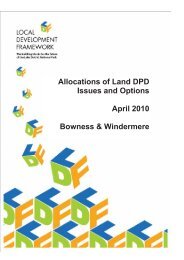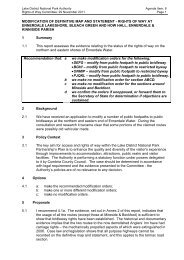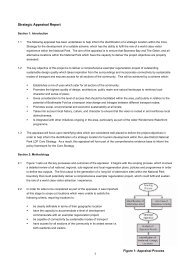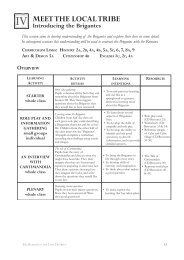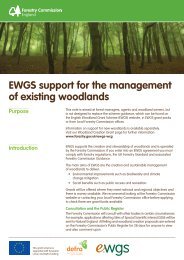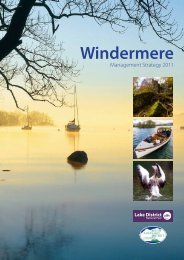The Partnership's Plan - Lake District National Park
The Partnership's Plan - Lake District National Park
The Partnership's Plan - Lake District National Park
Create successful ePaper yourself
Turn your PDF publications into a flip-book with our unique Google optimized e-Paper software.
<strong>The</strong> Low-carbon <strong>Lake</strong> <strong>District</strong> work complements the Cumbria Climate Change Action <strong>Plan</strong><br />
(2009-2014) produced by Cumbria County Council and the Cumbria Strategic Partnership.<br />
Focusing solely on the <strong>Lake</strong> <strong>District</strong>, it expands on Local Development Framework Core<br />
Strategy policies about climate change. It analyses what is being done to reduce carbon<br />
dioxide and other greenhouse gas emissions. Lastly, it puts forward medium term<br />
recommendations for a Low-carbon <strong>Lake</strong> <strong>District</strong> .<br />
Based on this and other research, there are six areas where we intend to make a difference by<br />
reducing our own emissions and inspiring others:<br />
1. We will work to develop community energy solutions, with small-scale energy<br />
generation linked to other energy saving measures.<br />
2. A sustainable transport strategy will offer a workable alternative to private car travel,<br />
which would bring other benefits, including reduced congestion and parking problems.<br />
3. In diversifying employment we will develop a green business hub well related to or in<br />
a rural service centre, encouraging low-carbon businesses and services to locate in the<br />
<strong>National</strong> <strong>Park</strong>.<br />
4. We will position the <strong>Lake</strong> <strong>District</strong> as an environmental enabler – inspiring visitors to<br />
take action on climate change.<br />
5. We will join other <strong>National</strong> <strong>Park</strong>s to encourage holidays at home – low-impact<br />
domestic tourism.<br />
6. And we will look at evolving landscapes – joining together debates about<br />
conservation and climate change, to examine how the landscape and biodiversity of the<br />
<strong>Lake</strong>s will change over time, and how it can best adapt to future climate change.<br />
3.14.4 Key partners<br />
This Low-carbon <strong>Lake</strong> <strong>District</strong> activity, whilst commissioned and branded by the <strong>National</strong><br />
<strong>Park</strong> Authority, has been supported by the <strong>Lake</strong> <strong>District</strong> <strong>National</strong> <strong>Park</strong> Partnership. <strong>The</strong> report<br />
shows how tackling climate change can help realise the Vision. Other partners undertaking<br />
work on mitigation and adaptation include <strong>National</strong> Trust, Forestry Commission, Cumbria<br />
Wildlife Trust, Environment Agency, <strong>National</strong> Farmers Union, ACT ( through its work<br />
supporting and developing the NW Upland Farming Forum ) and the Royal Society for<br />
Protection of Birds.<br />
3.15 Landscape, biodiversity and ecosystem services<br />
3.15.1 Facts and challenges<br />
• <strong>The</strong> individual character of each <strong>Lake</strong>land valley reflects the topography, land use and<br />
local materials available. It is this unique mix which gives each area a visual and<br />
cultural distinctiveness of its own, as well as a diversity of flora and fauna which<br />
contributes to the quality of the <strong>National</strong> <strong>Park</strong> as a whole. It is the existing landscape<br />
character and local distinctiveness which is taken into account in land use and land<br />
management decisions. <strong>The</strong> landscape has evolved over time and the process of<br />
change will continue.<br />
60



